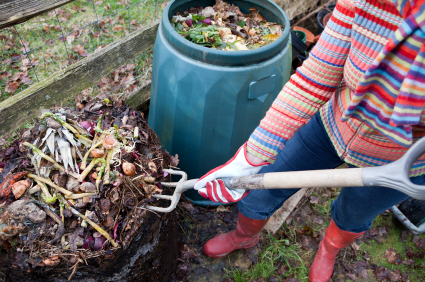
When it comes to green hobbies, few activities are more eco-friendly than gardening. With some healthy soil, a little bit of water and a few seeds, even the least-experienced gardener can produce beautiful, organic fruits, vegetables and flowers. But, a home garden does not have to just be for food and fun. With a little bit of effort, it can also be a great place to put food and yard waste to work.
Why mulch?
Mulch is a great gardener’s secret weapon. It mimics the layer of organic debris found on the ground in natural systems (think of the leaves piled up in the woods in fall), and helps protects plants from the many punishments Mother Nature dishes out. A properly applied layer of mulch provides a number of garden benefits:
- By insulating the soil, mulch helps plant roots maintain an even temperature and will protect vulnerable spring seedlings from frost.
- Mulch prevents evaporation from the soil and increases the amount of water available to plants.
- As it decays, mulch fertilizes the soil.
- Mulch acts a physical barrier to prevent weeds from germinating.
- A layer of mulch will help prevent topsoil erosion.
Making mulch
Mulch can be found at any garden store, but it is also easy to make at home, which offers you the chance to reuse home and yard waste that might otherwise get thrown away. Please note that most of these mulch recipes take anywhere from a few days to a few months to get right, so it is always a good idea to plan ahead.
Wood chips
Most store-bought mulches are simple wood chips, which means that anyone with a yard full of tree trimmings can make their own. The first step is chopping up branches and other tree debris, which can easily be done with a wood chipper (The Home Depot and Lowes both offer daily rentals of chippers and other lawn equipment).
That fresh pile of chips cannot go directly on your yard or garden bed, though. Because tree trimmings are so carbon-rich, if applied as is, they will upset the balance of nutrients in the soil. To keep the carbon/nitrogen ratio where it needs to be, mix the fresh wood chips with a nitrogen-rich material like leaves or blood meal, then let the pile rest. The mixture can be used fresh, but chips that have been allowed to decompose slightly — ideally over six to eight months — make the most nutritious mulch.
Compost
Composted yard and kitchen scraps make for excellent mulch. Because a good compost pile will already have a mix of carbon and nitrogen, there is no need to worry about the mulch upsetting the nutrient balance of the soil.
Grass clippings
Like wood chips, grass clippings can also be used for mulching, but they require a little bit of extra care. This nitrogen-rich debris will rapidly heat up as it decomposes and can also quickly compress into a dense pile that smothers the soil (the air pockets in wood chips and compost are part of what make them such good insulators). Composting them with carbon-rich waste before using them as mulch is the best way to make use of grass clippings.
Newspaper
For gardeners with weed problems, newspaper mulch can offer a quick and easy solution. Just put down a layer of paper several pages thick around already sprouted plants and cover with a thin coating of wood chips or compost. The extra insulation from the paper does a great job of stopping even the most insistent weeds, and also helps trap more moisture than wood chips alone. Again, because paper products are so carbon heavy, it’s important when using newspaper as a mulch to ensure that the soil gets added nitrogen as well.
Whichever mulch you decide to use, keep in mind that every garden is different. Issues like soil temperature, moisture level and nutrient balance will vary from place to place, and can even be different within the same yard. So, the best way to find out what works best is just to get out there and experiment.
Do you have a composting secret? Share it with us in the comments section!
